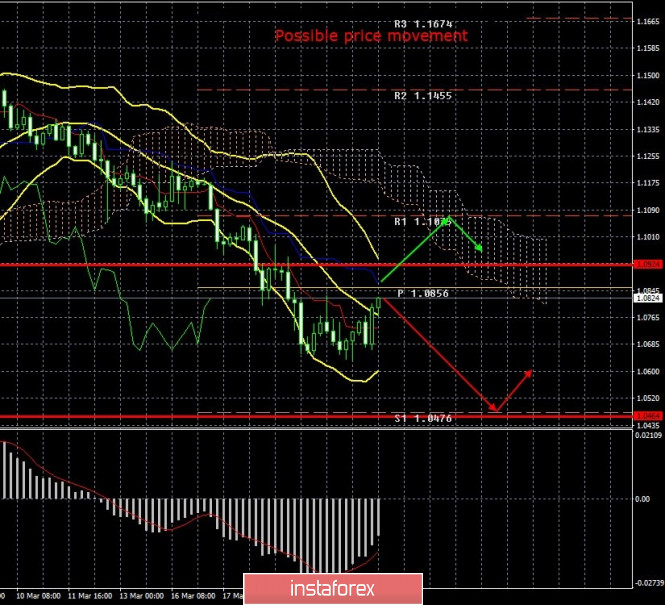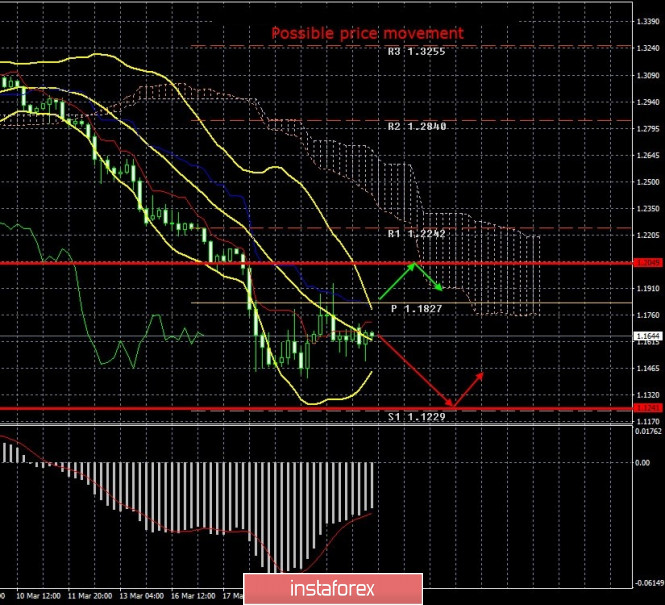4-hour timeframe

Average volatility over the past 5 days: 230p (high).
The EUR/USD currency pair did not fall in price again on Monday, March 23. Thus, there have been no new declines in the European currency for several consecutive days, and the pair has even begun to adjust today. However, it is still too early to talk about the end of the panic in the market. The volatility of the euro/dollar pair remains extremely high, and today quotes have passed almost 200 points. Despite the fact that no macroeconomic statistics were planned for Monday, and indeed new and fresh data was not available to traders. However, in any case, traders in recent weeks have not reacted to almost all statistics. Nearly all reports about the actions of the central bank or the governments of the European Union and the United States were also ignored. Thus, today's movement may be a correction, it could be the beginning of a new strong upward trend. Markets remain in a state of panic, so movement can be expected in any direction.
A few days ago, we wrote about the forecasts for the fall of the global economy, which were given by Goldman Sachs and world rating agencies. Recall that initially experts assumed that the global economy would lose from 0.5% to 1.5% of GDP in 2020. However, everything will depend on the duration of the epidemic and the losses that it will bring. Now, Morgan Stanley economists voiced their forecasts. In their opinion, US GDP will decline by 30.4% in the second quarter, which corresponds to the level of the Great Depression. "We are seeing a 2.4% drop in GDP in the first quarter, as economic activity almost stopped in March. In the second quarter, a record decline of 30.1% will follow. We expect a sharp decline in consumer spending on travel, restaurants, transportation and other services," the forecast said. However, we would like to note that these are just forecasts. The fact that there will be reductions in the US economy, and in the European, and in the world - there is no need to go to a fortune teller. However, why guess what they will be? Better to wait for the official statistics. Data will begin to be available to traders tomorrow. This refers to statistics for March.
At the same time, the International Monetary Fund announced its forecasts regarding the COVID-2019 pandemic and its impact on the global economy. According to Martin Muhleisen, director of the IMF's strategy, policy and analysis department, the consequences will be extremely dire, but they will ultimately be overcome. First of all, the sectors of tourism, services and any industries related to the interaction and movement of people will suffer. Economic activity will decrease very much, demand will decrease, therefore, production will also fall, which in the US and the EU has already declined over the past six months. However, according to Muhleisen, financial institutions and central banks made the right conclusions after the 2008 crisis, and the current pandemic will turn out to be "tough for them". The IMF also notes that business activity in China has begun to recover. The first quarter is likely to be completely disastrous, but in the second there will already be a restoration of economic indicators, since it was possible to localize the pandemic in China.
Meanwhile, the US stock market is still not happy. On Monday, March 23, major stock indexes reopened lower despite the fact that the Federal Reserve announced an unprecedented program to help the economy. The Dow Jones Industrial Average fell almost 1%, the S&P 500 lost 0.6%, and the Nasdaq Composite immediately dropped 0.5%. However, this is only at the opening of trading. More serious price changes may occur during the day.
Russian oil companies agreed to give Belarus a discount of $15.7 per tonne of Urals oil and thus resume deliveries that stopped at the beginning of the year from April 1. This is bad news for the oil market. The more discounts exporting countries provide, the longer the period of low oil prices will remain. All oil brands became cheaper again at today's auction. As you can see, markets continue to be under pressure, so "calm Monday" may turn out to be an accident.
4-hour timeframe

Average volatility over the past 5 days: 404p (high).
As for the British pound, this currency did not even manage to correct normally on Monday. On the other hand, correction was observed earlier. In technical terms, the pound/dollar pair ideally worked out the critical Kijun-sen line, and a rebound from it provoked a resumption of the downward movement. Thus, from a technical point of view, everything is in order, everything is going according to plan. However, questions remain: how long will the British pound fall, which objectively does not deserve such a fate? In the United States, according to recent data, the number of people infected with a pandemic has increased. And the Fed and the government are going to pour not hundreds of billions of dollars, but trillions into the economy. Accordingly, damage to the economy can be colossal. We do not yet have macroeconomic statistics from across the ocean. However, the US government has. And since it introduces such colossal incentive measures, then everything is really bad. The number of infected is not too large in the UK. Nevertheless, the pound again shows a genuine desire to collapse.
In the UK, as well as in many countries of the world, the fight against the virus continues. However, judging by the statements of the country's Prime Minister Boris Johnson, who promises to introduce more stringent quarantine measures, the country's population neglects the rules that have already been introduced. It is reported that last weekend the British gathered in droves in parks, on beaches, in markets. Thus, Johnson intends to transfer Britain to quarantine like Italy, where there are strict bans on leaving citizens without an emergency. "To everyone who goes out, plays sports, has fun, I strongly declare: you must observe distance. If you cannot do this, then we will have to take tougher measures," Johnson said. As for the technical picture of the GBP/USD currency pair, the downward movement is likely to resume. But it is very difficult to say as to what can save the pound. The panic continues to remain in the markets, so we believe that we still need to wait for the downward turn. Bidding can become more logical and reasonable only after that.
Recommendations for EUR/USD:
For short positions:
The euro/dollar continues to have a corrective movement on the 4-hour timeframe. Thus, it is recommended to sell the euro in case of a price rebound from the Kijun-sen line with the target of the support level of 1.0476.
For long positions:
Buying the EUR/USD pair is recommended only if quotes return to the area above the critical line with the first goal, the resistance level is 1.1075. However, when opening any positions, it is recommended to act as carefully as possible and remember the heightened risks.
Recommendations for GBP/USD:
For short positions:
The pound/dollar resumed its downward movement after a rebound from the Kijun-sen line. Thus, it is recommended to sell the British pound while aiming to support the level of 1.1229 until new signs of correction start.
For long positions:
Buying the GBP/USD pair is recommended only if quotes return to the area above the Kijun-sen line with the first goal being the resistance level of 1.2242. As in the case of the euro currency, it is recommended to remember the heightened risks when opening any positions.
Explanation of the illustration:
Ichimoku indicator:
Tenkan-sen is the red line.
Kijun-sen is the blue line.
Senkou Span A - light brown dotted line.
Senkou Span B - light purple dashed line.
Chikou Span - green line.
Bollinger Bands Indicator:
3 yellow lines.
MACD indicator:
Red line and bar graph with white bars in the indicators window.
Support / Resistance Classic Levels:
Red and gray dashed lines with price symbols.
Pivot Level:
Yellow solid line.
Volatility Support / Resistance Levels:
Gray dotted lines without price designations.
Possible price movements:
Red and green arrows.
The material has been provided by InstaForex Company - www.instaforex.com